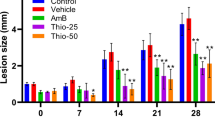Abstract
Leishmaniasis is caused by species of the protozoan parasite Leishmania. It is the third most important vector-borne disease and is widely distributed throughout the world. The World Health Organization recommends pentavalent antimonials as drugs of first choice in its treatment. Although Glucantime® has traditionally been used to treat leishmaniasis, there are still many questions about its structure, mechanisms of action and ability to induce damage in DNA. In this study, the genotoxic activity of this drug was evaluated in vitro using human lymphocytes treated for 3 and 24 h (comet assay) and 48 h (apoptosis assay) with 3.25, 7.5 and 15 mg/ml of Glucantime®, respectively, corresponding to 1.06, 2.12 and 4.25 mg/ml of pentavalent antimony. In the in vivo tests, Swiss mice received acute treatment with three doses (212.5, 425 and 850 mg/kg) of pentavalent antimony. All the treatments were administered intraperitoneally in the volumes of 0.1 ml/10 g of body weight, adapting human exposure to murine conditions. The animals were treated for 3 h in the comet assay using resident peritoneal exudate macrophages, for 24 h in the comet assay using peripheral blood leukocytes and for 24 h in the bone marrow erythrocyte micronucleus test. While no genotoxic effect was observed in the in vitro tests, the in vivo tests showed that Glucantime® induces DNA damage. These findings indicate that Glucantime® is a pro-mutagenic compound that causes damage to DNA after reduction of pentavalent antimony (SbV) into the more toxic trivalent antimony (SbIII) in the antimonial drug meglumine antimoniate.
Similar content being viewed by others
References
Ayres M, Ayres M Jr, Ayres DL, Santos AS (2005) Bioestat 5.0: Aplicações estatísticas nas áreas das ciências biomédicas. Sociedade Civil Mamirauá, MCT-CNPq. Belém, Pará
Balanã-Fouce R, Reguera RM, Cubría JC, Ordóñez D (1998) The pharmacology of leishmaniasis. Gen Pharmac 30:435–443
Boeck M, Kirsch-Volders M, Lison D (2003) Cobalt and antimony: genotoxicity and carcinogenicity. Mutat Res 533:135–152
Demicheli C, Frézard F, Lecouvey M, Garnier-Suillerot A (2002) Antimony (V) complex formation with adenine nucleoside in aqueous solution. Bioch Biophys Acta 1570:192–193
Dive C, Gregory CD, Phipps DJ, Evans DL, Milner AE, Wyllie AW (1992) Analysis and discrimination of necrosis and apoptosis (programmed cell death) by multiparameter flow cytometry. Bioch Biophys Acta 1133:275–285
Elia MC, Storer RD, Harmon LS, Kraynak AR, Mckelvey TW, Hertzog PR, Keenan KP, Deluca JG, Nichols WW (1993) Cytotoxicity as measured by trypan blue as a potentially confounding variable in the in vitro alkaline elution/rat hepatocyte assay. Mutat Res 291:193–205
Ferreira CS, Martins PS, Demicheli C, Brochu C, Ouellette M, Frézard F (2003) Thiol-induced reduction of antimony (V) into antimony (III): a comparative study with trypanothione, cysteinyl-glycine, cysteine and glutathione. Biometals 16:441–443
Frézard F, Demicheli C, Ferreira CS, Costa MA (2001) Glutathione induced conversion of pentavalent antimony to trivalent antimony in meglumine antimoniate. Antimicrob Agents Chemother 45:913–916
Gurnani N, Sharma A, Talukder G (1992) Cytotoxic effects of antimony trichloride in vivo. Cytobios 70:131–136
Hantson P, Léonard ED, Crutzen-Fayt MC, Léonard A, Vandercam B, Delaere B, Mahieu P (1996) Cytogenetic observations after meglumine antimoniate therapy for visceral leishmaniasis. Pharmacotherapy 16:869–871
Heddle JA (1973) A rapid in vivo test for chromosomal damage. Mutat Res 18:187–190
Léonard A, Gerber GB (1996) Mutagenicity, carcinogenicity and teratogenicity of antimony compounds. Mutat Res 366:1–8
Lucumi A, Robledo S, Gama V, Saravia NG (1998) Sensitivity of Leishmania viannia panamensis to pentavalent antimony is correlated with the formation of cleavable DNA-protein complexes. Antimicrob Agents Chemother 42:1990–1995
Paton GR, Allison AC (1972) Chromosome damage in human cell cultures induced by metal salts. Mutat Res 16:332–336
Reithinger R, Dujardin JC (2007) Molecular diagnosis of leishmaniasis: current status and future applications. J Clin Microbiol 45:21–25
Roberts WR, McMurray WJ, Rainey PM (1998) Characterization of the antimonial antileishmanial agent meglumine antimoniate (glucantime). Antimicrob Agents Chemother 42:1076–1082
Sereno D, Holzmuller P, Mangot I, Cuni G, Lemesre J (2001) Antimonial-mediated DNA fragmentation in Leishmania infantum amastigotes. Antimicrob Agents Chemother 45:2064–2068
Shaked-Mishan P, Ulrich N, Ephros M, Zilberstein D (2001) Novel intracellular Sb (V) reducing activity correlates with antimony susceptibility in Leishmania donovani. J Biol Chem 276:3971–3976
Singh NP, Mccoy MT, Tice RR, Schneider EL (1988) A simple technique for quantitation of low levels of DNA damage in individual cells. Exp Cell Res 175:184–191
Speit G, Hartmann A (1995) The contribution of excision repair to the DNA effects seen in the alkaline single cell gel test (comet assay). Mutagenesis 10:555–559
Tice RR, Agureel E, Anderson D, Burlison B, Hartmann A, Kobayashi H (2000) Single cell gel/comet assay: Guidelines for in vitro and in vivo genetic toxicology testing. Environ Mol Mutagen 35:206–221
Acknowledgments
We wish to express our gratitude to CAPES/PET—Biology (Coordenação de Aperfeiçoamento de Pessoal de Nível Superior, Programa de Educação Tutorial—Biologia) from Federal University of Maranhão by the junior fellowship.
Conflict of interest statement
The authors declare that there are no conflicts of interest.
Author information
Authors and Affiliations
Corresponding author
Rights and permissions
About this article
Cite this article
Lima, M.I.S., Arruda, V.O., Alves, E.V.C. et al. Genotoxic effects of the antileishmanial drug glucantime® . Arch Toxicol 84, 227–232 (2010). https://doi.org/10.1007/s00204-009-0485-0
Received:
Accepted:
Published:
Issue Date:
DOI: https://doi.org/10.1007/s00204-009-0485-0




